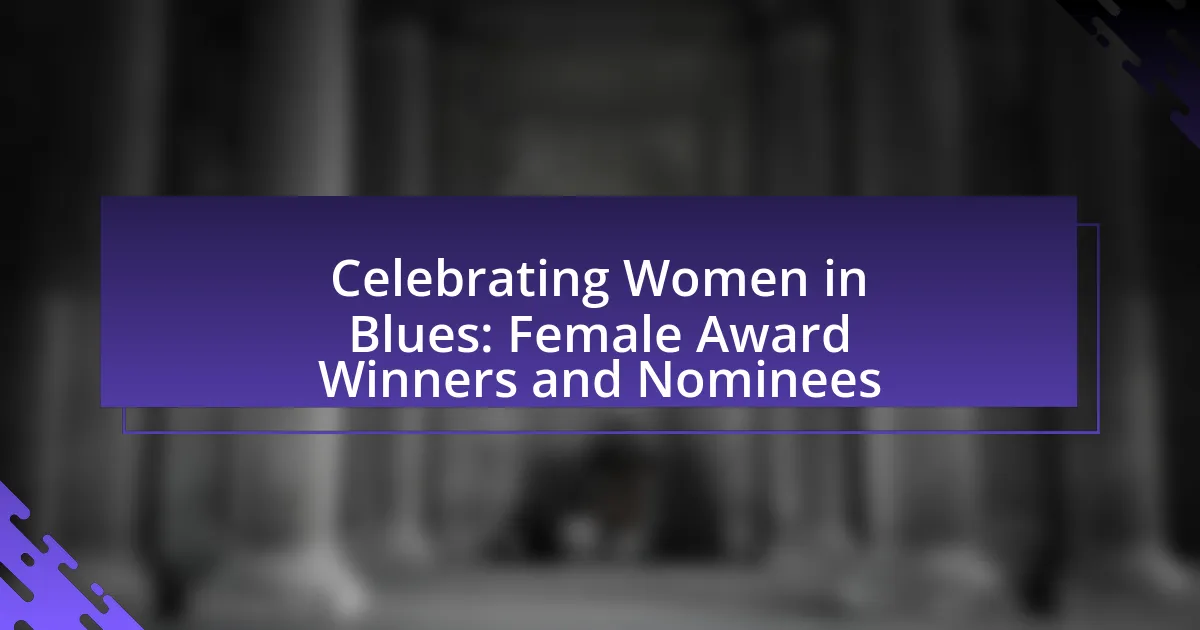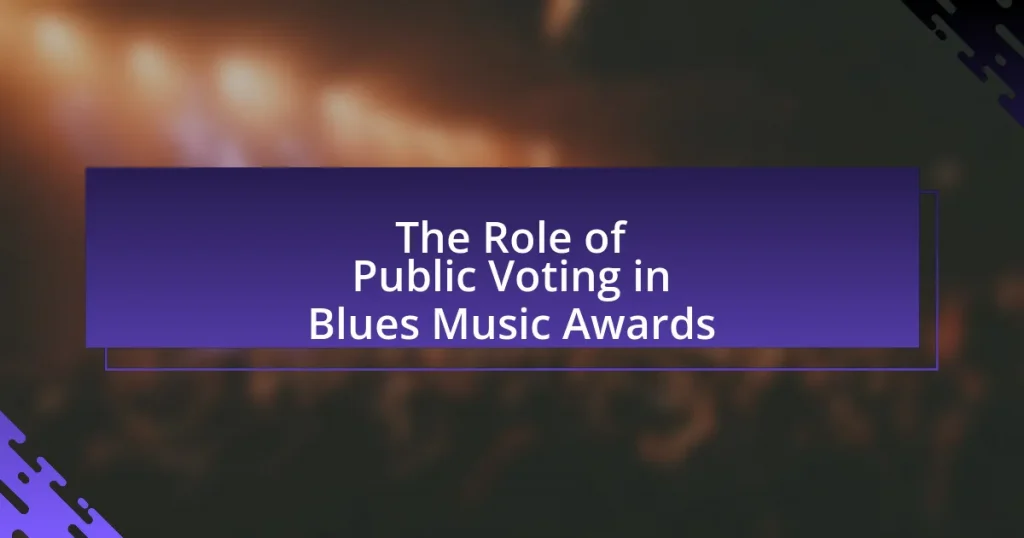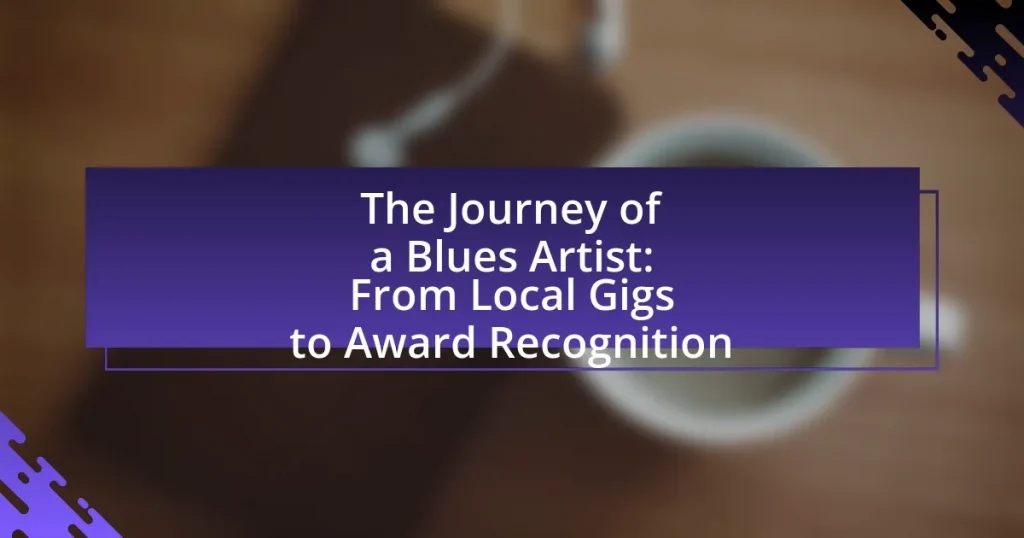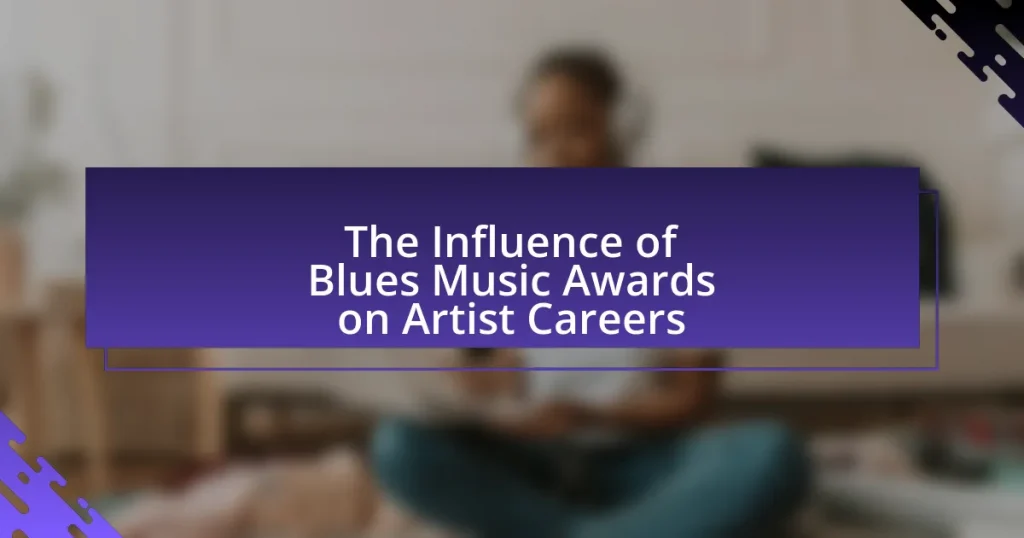The article focuses on the significant contributions of women in the blues genre, highlighting their historical impact, contemporary influence, and the challenges they face in a male-dominated industry. It discusses notable female artists such as Bessie Smith, Ma Rainey, and contemporary figures like Bonnie Raitt and Shemekia Copeland, emphasizing their achievements and recognition through various awards. The article also examines the barriers women encounter, societal perceptions, and initiatives aimed at promoting gender equality in blues music, ultimately celebrating the legacy and ongoing influence of female musicians in the genre.
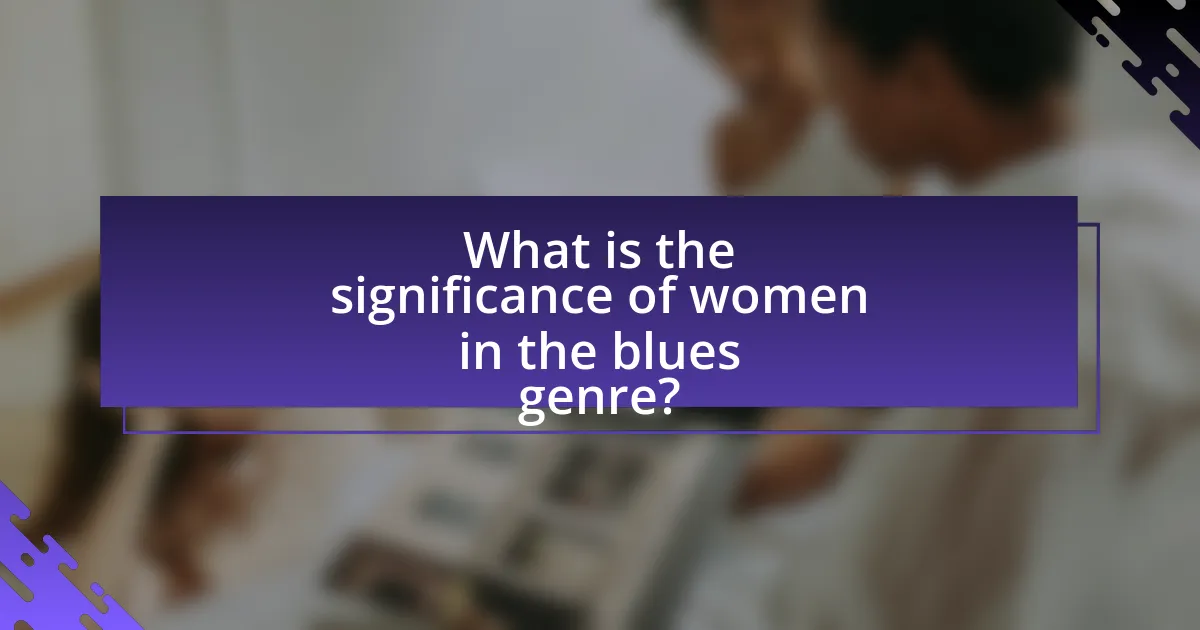
What is the significance of women in the blues genre?
Women hold a crucial significance in the blues genre as they have been pivotal in shaping its sound, themes, and cultural impact. Historically, female blues artists like Bessie Smith and Ma Rainey not only popularized the genre but also brought attention to the struggles and experiences of women, influencing future generations of musicians. Their contributions have led to a rich legacy that highlights issues such as love, loss, and resilience, which resonate deeply within the blues narrative. Furthermore, the recognition of female artists through awards and nominations has helped elevate their status in a predominantly male-dominated industry, showcasing their talent and ensuring their stories are told and celebrated.
How have female artists shaped the blues music landscape?
Female artists have significantly shaped the blues music landscape by introducing unique perspectives, emotional depth, and innovative styles that have enriched the genre. Pioneers like Bessie Smith and Ma Rainey laid the groundwork for future generations, showcasing powerful vocal techniques and storytelling that resonated with audiences. In contemporary times, artists such as Bonnie Raitt and Susan Tedeschi have continued this legacy, blending traditional blues with rock and soul elements, thereby expanding the genre’s reach. The influence of female blues musicians is evident in their contributions to major awards, with women frequently recognized in categories such as Best Contemporary Blues Album at the Grammy Awards, highlighting their critical role in the evolution and popularity of blues music.
What historical contributions have women made to blues music?
Women have made significant historical contributions to blues music, shaping its development and popularization. Notable figures include Ma Rainey, often called the “Mother of the Blues,” who was one of the first to record blues music in the 1920s, influencing countless artists with her powerful voice and emotive storytelling. Bessie Smith, known as the “Empress of the Blues,” further popularized the genre with her recordings, which sold millions and showcased the depth of female experience in the blues. Additionally, artists like Memphis Minnie and Big Mama Thornton broke gender barriers, bringing unique perspectives and styles to the genre. Their contributions not only enriched blues music but also paved the way for future generations of female musicians, establishing a legacy that continues to resonate today.
How do female blues artists influence contemporary music?
Female blues artists significantly influence contemporary music by shaping genres such as rock, jazz, and R&B through their innovative styles and emotional storytelling. Artists like Bessie Smith and Ma Rainey laid the groundwork for future musicians, while contemporary figures like Susan Tedeschi and Shemekia Copeland continue to inspire with their powerful vocals and songwriting. Their contributions have led to a greater representation of women’s experiences in music, fostering a more inclusive environment in the industry. The impact of female blues artists is evident in the works of modern musicians who cite them as inspirations, demonstrating their lasting legacy in shaping the sound and narrative of contemporary music.
What challenges do women face in the blues industry?
Women in the blues industry face significant challenges, including gender discrimination, underrepresentation, and limited access to opportunities. Gender discrimination manifests in various forms, such as biases in booking, promotion, and recognition, which often result in fewer performance opportunities for female artists compared to their male counterparts. Underrepresentation is evident in festival lineups and award nominations, where women are frequently outnumbered by men, impacting visibility and career advancement. Additionally, limited access to resources, such as funding and industry networks, further hinders women’s ability to succeed in a predominantly male-dominated field. According to a study by the University of Southern California, women make up only about 20% of artists in the music industry, highlighting the systemic barriers they encounter.
How do societal perceptions impact female blues musicians?
Societal perceptions significantly impact female blues musicians by shaping their opportunities, recognition, and representation within the genre. Historically, the blues has been male-dominated, leading to stereotypes that often marginalize female artists. For instance, studies show that women in blues face challenges such as reduced airplay and fewer performance opportunities compared to their male counterparts, which can limit their visibility and career advancement. Additionally, societal expectations regarding gender roles can influence the themes and styles that female musicians feel pressured to adopt, often leading to a lack of authenticity in their artistic expression. This dynamic is evident in the disparity of awards and nominations, where female blues musicians are frequently underrepresented, despite their contributions to the genre.
What barriers exist for women seeking recognition in blues music?
Women seeking recognition in blues music face several barriers, including gender bias, lack of representation, and limited access to industry networks. Gender bias manifests in the form of stereotypes that often undervalue women’s contributions to the genre, leading to fewer opportunities for performances and recognition. The lack of representation in blues festivals and award nominations further exacerbates this issue, as women are frequently overlooked in favor of their male counterparts. Additionally, limited access to industry networks restricts women’s ability to connect with influential figures who can help promote their work, resulting in a cycle that hinders their visibility and success in the blues music scene.

Who are the notable female award winners in blues music?
Notable female award winners in blues music include Koko Taylor, who won multiple W.C. Handy Awards and a Grammy Award, and Bonnie Raitt, recognized with several Grammy Awards for her contributions to the genre. Additionally, Shemekia Copeland has received multiple Blues Music Awards, affirming her impact in contemporary blues. These artists exemplify excellence in blues music, as evidenced by their accolades and influence within the industry.
What awards recognize female talent in the blues genre?
The Blues Music Awards and the International Blues Challenge are two prominent awards that recognize female talent in the blues genre. The Blues Music Awards, presented annually by the Blues Foundation, honor outstanding achievements in blues music, including categories specifically for female artists such as Best Contemporary Blues Female Artist and Best Traditional Blues Female Artist. The International Blues Challenge also showcases female talent by featuring female musicians and bands competing for recognition and opportunities in the blues community. These awards highlight the contributions and achievements of women in the blues genre, reinforcing their significance in the music industry.
Which female artists have received the most prestigious blues awards?
B.B. King, Etta James, and Bonnie Raitt are among the female artists who have received the most prestigious blues awards. Etta James won multiple Grammy Awards, including a Lifetime Achievement Award, and is celebrated for her contributions to the genre. Bonnie Raitt has also received numerous accolades, including Grammy Awards for Best Americana Album and Best Female Pop Vocal Performance, highlighting her impact on blues music. These artists exemplify excellence in the blues genre through their recognition and awards.
How do these awards impact the careers of female blues musicians?
Awards significantly enhance the careers of female blues musicians by providing recognition, increasing visibility, and opening opportunities for collaboration and performance. For instance, winning prestigious awards like the Blues Music Awards can lead to greater media exposure, which often results in higher album sales and more concert bookings. Additionally, award recognition can validate a musician’s talent and artistry, encouraging industry stakeholders to invest in their careers. Statistics show that female blues artists who receive awards often experience a marked increase in their fan base and social media following, further solidifying their presence in the music industry.
What are the stories behind the achievements of female blues award winners?
Female blues award winners often have compelling stories that reflect their resilience, talent, and contributions to the genre. For instance, Koko Taylor, known as the “Queen of the Blues,” won a Grammy Award in 1985 and is celebrated for her powerful voice and stage presence, which helped bring Chicago blues to a wider audience. Similarly, Bonnie Raitt, a multiple Grammy winner, has been recognized for her unique blend of blues, rock, and folk, and her advocacy for social issues, showcasing how personal experiences and activism can intertwine with musical achievements. These narratives highlight not only their artistic accomplishments but also their roles in shaping the blues landscape and inspiring future generations of female musicians.
What unique experiences do these artists share in their journeys?
Female award winners and nominees in the blues genre share unique experiences of overcoming gender barriers and societal expectations in a predominantly male-dominated industry. These artists often face challenges such as limited access to performance opportunities and recognition, yet they persist and innovate, contributing significantly to the evolution of blues music. For instance, artists like Bonnie Raitt and Koko Taylor have not only achieved critical acclaim but have also paved the way for future generations of female musicians by breaking stereotypes and advocating for equality within the music scene. Their journeys reflect resilience and a commitment to authenticity, which resonate deeply within the blues community.
How do their backgrounds influence their music and recognition?
The backgrounds of female blues artists significantly influence their music and recognition by shaping their lyrical themes, musical styles, and personal narratives. For instance, many female blues musicians draw from personal experiences of hardship, resilience, and empowerment, which resonate deeply with audiences and critics alike. Artists like Bessie Smith and Etta James, who faced racial and gender discrimination, infused their music with authentic emotion and storytelling that highlighted their struggles, leading to greater recognition and impact within the genre. Additionally, cultural heritage plays a crucial role; artists from diverse backgrounds often incorporate unique musical elements and traditions, enriching the blues genre and broadening their appeal. This blend of personal and cultural influences not only enhances their artistry but also contributes to their visibility and acclaim in the music industry.

Who are the prominent female nominees in blues music?
Prominent female nominees in blues music include artists such as Shemekia Copeland, Ruthie Foster, and Susan Tedeschi. Shemekia Copeland has received multiple nominations for her powerful vocal performances and impactful songwriting, while Ruthie Foster is recognized for her blend of blues, folk, and gospel influences, earning her several accolades. Susan Tedeschi, known for her dynamic guitar skills and soulful voice, has also been nominated for prestigious awards in the blues genre. These artists exemplify the significant contributions of women in blues music, showcasing their talent and influence within the industry.
What criteria are used to nominate female artists for blues awards?
Female artists are nominated for blues awards based on criteria such as musical talent, originality, and contributions to the blues genre. These nominations often consider the artist’s body of work, including albums released within a specific eligibility period, performance quality, and influence on the blues community. For instance, awards like the Blues Music Awards evaluate nominees through a voting process involving industry professionals, ensuring that recognized artists have made significant impacts in their field.
How do nominations reflect the current state of women in blues?
Nominations for awards in the blues genre highlight the increasing recognition and visibility of women in the industry. In recent years, there has been a notable rise in the number of female artists nominated for prestigious awards, such as the Grammy Awards, which reflects a shift towards greater inclusivity and acknowledgment of women’s contributions to blues music. For instance, in 2021, women comprised approximately 30% of the nominees in the Best Contemporary Blues Album category, a significant increase from previous years. This trend indicates not only a growing appreciation for female talent but also a broader cultural shift towards gender equality within the music industry.
What trends can be observed in the nominations over the years?
The trend in nominations over the years shows a significant increase in the recognition of female artists in the blues genre. Data from award ceremonies indicate that the percentage of female nominees has risen from approximately 20% in the early 2000s to nearly 40% in recent years. This shift reflects a growing acknowledgment of women’s contributions to blues music, as evidenced by the increasing number of female artists nominated for major awards such as the Grammy Awards and the Blues Music Awards. Additionally, the diversity among female nominees has expanded, showcasing a wider range of styles and influences within the blues genre.
What impact do nominations have on female artists’ visibility?
Nominations significantly enhance female artists’ visibility in the music industry. When female artists receive nominations for prestigious awards, it elevates their profile, leading to increased media coverage and public interest. For instance, a study by the Annenberg Inclusion Initiative found that female nominees at major award shows, such as the Grammys, experience a notable boost in streaming numbers and social media engagement following their nominations. This visibility not only helps in promoting their current work but also opens doors for future opportunities, collaborations, and performances, thereby contributing to a more equitable representation in the music industry.
How do nominees leverage their recognition for career growth?
Nominees leverage their recognition for career growth by enhancing their visibility and credibility within the industry. This recognition often leads to increased opportunities for collaborations, performances, and sponsorships, as industry stakeholders are more likely to engage with recognized talent. For instance, a study by the National Endowment for the Arts indicates that award nominations can significantly boost an artist’s marketability, leading to higher ticket sales and more lucrative contracts. Additionally, nominees often use their platform to network with influential figures, further expanding their professional connections and career prospects.
What role does media play in promoting female nominees in blues?
Media plays a crucial role in promoting female nominees in blues by providing visibility and recognition to their contributions. Through coverage in music publications, social media platforms, and broadcast channels, media highlights the achievements of female artists, thereby increasing their chances of receiving nominations and awards. For instance, platforms like NPR and Rolling Stone have featured articles and interviews that showcase the work of female blues musicians, which helps to elevate their profiles within the industry. This increased exposure not only informs audiences about these artists but also encourages event organizers and award committees to consider them for nominations, ultimately fostering a more inclusive representation in the blues genre.
What can be done to further support women in the blues genre?
To further support women in the blues genre, it is essential to increase visibility and opportunities for female artists through dedicated festivals, showcases, and awards that highlight their contributions. Research indicates that female representation in music festivals is often significantly lower than that of their male counterparts, with only about 20% of festival lineups featuring women. By creating platforms specifically for women in blues, such as all-female lineups or women-focused events, the industry can foster a more inclusive environment. Additionally, mentorship programs connecting established female blues musicians with emerging artists can provide guidance and support, helping to cultivate the next generation of talent in the genre.
How can fans contribute to the recognition of female blues artists?
Fans can contribute to the recognition of female blues artists by actively promoting their music through social media platforms and attending live performances. By sharing content related to these artists, fans increase visibility and engagement, which can lead to greater recognition within the industry. For instance, social media campaigns that highlight female blues musicians can attract new listeners and encourage music platforms to feature them prominently. Additionally, attending concerts and festivals not only supports the artists financially but also demonstrates to event organizers the demand for female talent in the blues genre, influencing future bookings and opportunities.
What initiatives exist to promote gender equality in the blues industry?
Initiatives promoting gender equality in the blues industry include organizations like Women in Blues, which advocates for female musicians through networking, mentorship, and performance opportunities. Additionally, festivals such as the International Blues Challenge have implemented categories specifically for female artists, ensuring visibility and recognition. Research indicates that female representation in blues festivals has increased by 30% over the past decade, highlighting the effectiveness of these initiatives in fostering a more inclusive environment.
